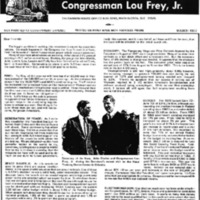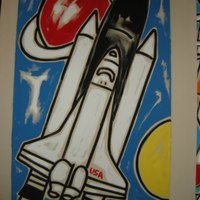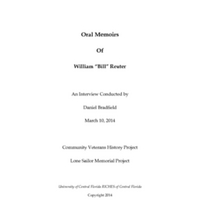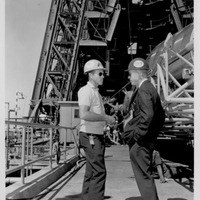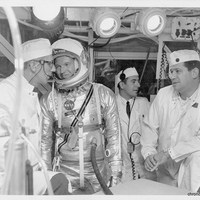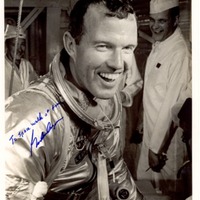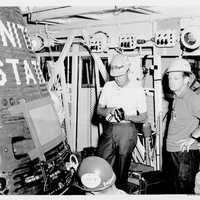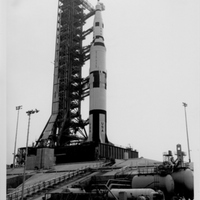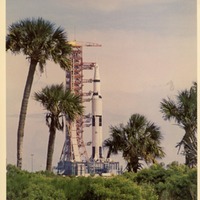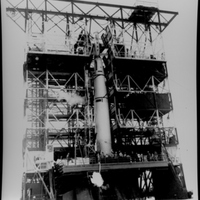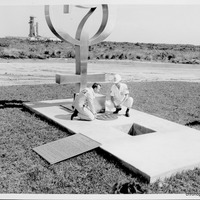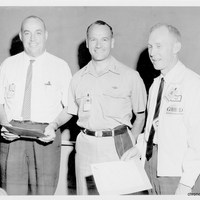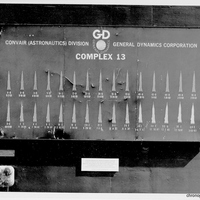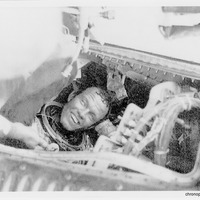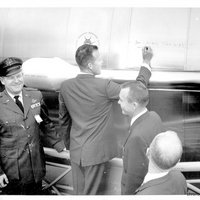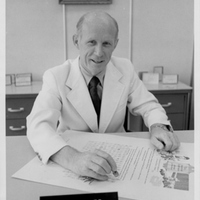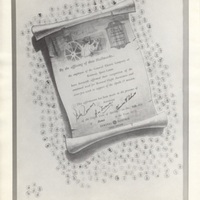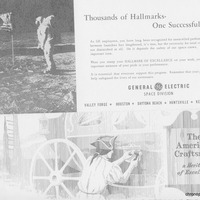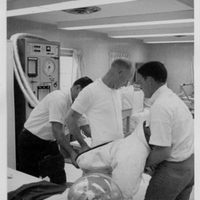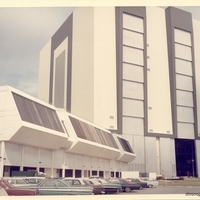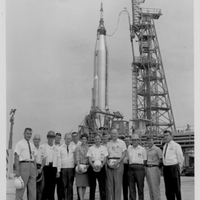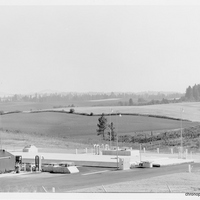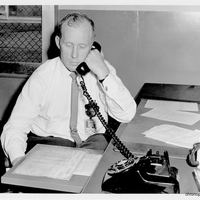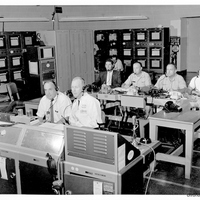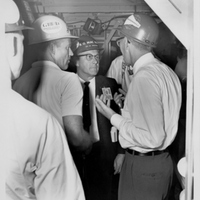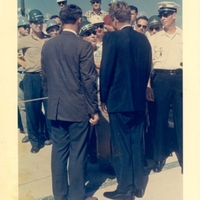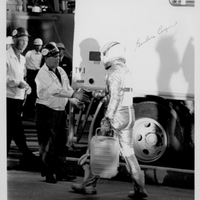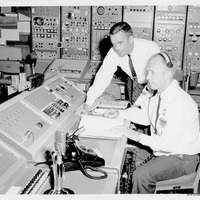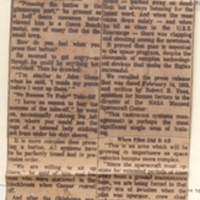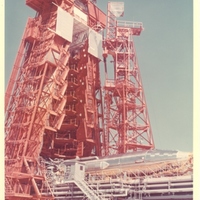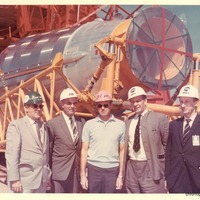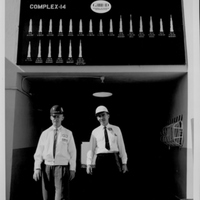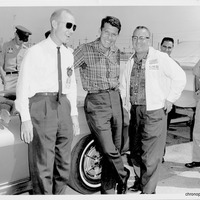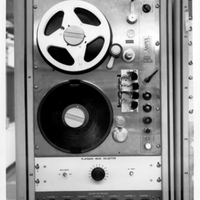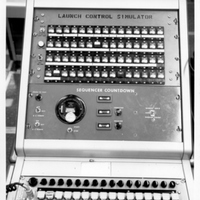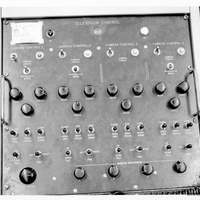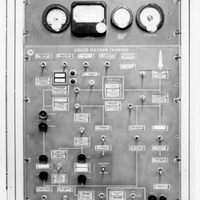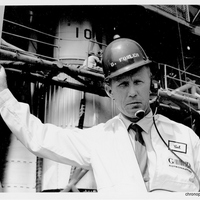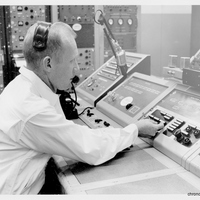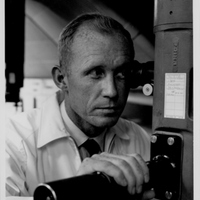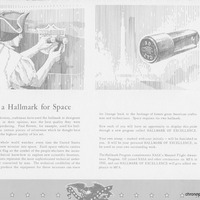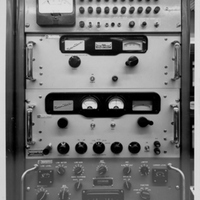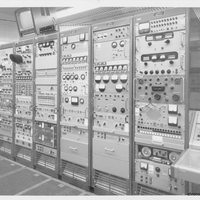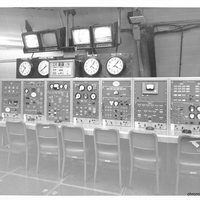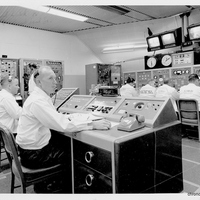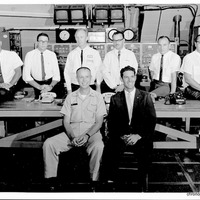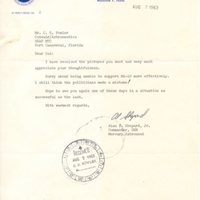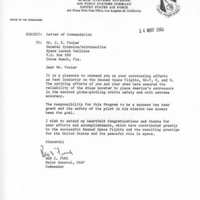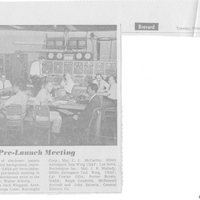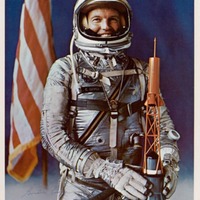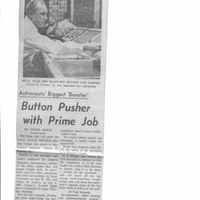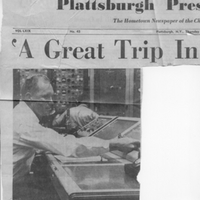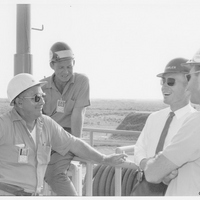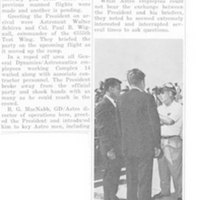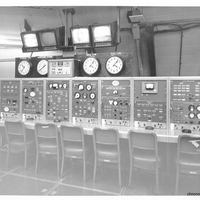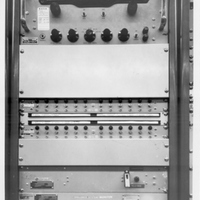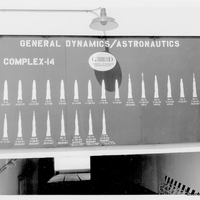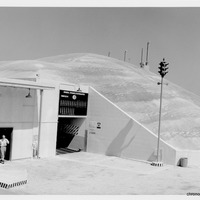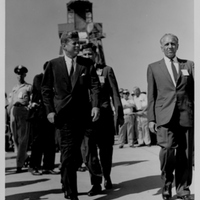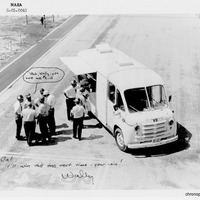Browse Items (68 total)
- Tags: outer space
Ramon's Postcard
Tags: Al Shepard; Alan Bartlett Shepard, Jr.; Alan Shepard; Astronaut Group 1; astronauts; Cocoa Beach; Deke Slayton; Donald Kent Slayton; Gordo Cooper; Gordon Cooper; Gus Grissom; John Glenn; John Herschel Glenn, Jr.; Leroy Gordon "Cooper, Jr.; Malcolm Scott Carpenter; Mercury 7; Mercury Seven; Original 7; Original Seven; outer space; Ramon's; restaurants; Scott Carpenter; space exploration; Surveyor I; Virgil Ivan Grissom; Wally Schirra; Walter Marty Schirra, Jr.
Florida From the House...To Your Home Newsletter, March 1972
Tags: Apollo 15; BC News; BCC; benzoylmethylecgonine; Bill Chappell; Brevard Community College; budgets; Cape Kennedy; China; Chris Frey; cocaine; Coke; colleges; Congress; deficits; DOL; Don Fuqua; drug task force; drug trafficking; drug wars; drugs; educational Florida Institute of Technology; election reform; FECA; Federal Election Campaign Act of 1971; FIT; Florida Technological University; FTU; heroin; James Day Hodgson; John Chafee; John Lester Hubbard Chafee; Jules Bergman; Julie Frey; Lake Apopka; lake restoration; Lauren Frey; Lou Frey; Lou Frey, Jr.; Louis Frey, Jr.; Lynne Frey; Manned Spaceflight; Marcia Frey; Marcia Turner; Mexico; MIA; Miami; missing in action; narcotics; NASA; National Aeronautics and Space Administration; Newsweek; OASDI; Oklawaha River Basin Improvement Council; Old-Age, Survivors, and Disability Insurance; Oscar Flores Sánchez; outer space; poppies; Poppy; POW; price controls; Prisoner of War; Regional Environmental Training and Research Organization; RETRO; Richard Milhous Nixon; Richard Nixon; Russia; Social Security; Social Security Trust Fund; Space Shuttles; Temporary Wage and Price Controls; U.S. Congress; U.S. Department of Labor; U.S. House of Representatives; U.S. Representatives; U.S. Senate; unemployment; universities; university; Vietnam War; wage busting; wage controls; War on Drugs; William V. Chappell, Jr.
A History of Central Florida, Episode 47: John Young's Flight Suit
Tags: A History of Central Florida; Amy Foster; astronaut; Bob Clarke; Bob Crippen; Cathleen Lewis Lewis; Central Boulevard; Challenger; Chip Ford; Daniel Velásquez; Downtown Orlando; Ella Gibson; John F. Kennedy Space Center; John Watts Young; Johnson Space Center; JSC; Katie Kelley; Kendra Hazen; Kennedy Space Center; KSC; launch; Lyndon B. Johnson Space Center; Merritt Island; military; Moon; NASA; National Aeronautics and Space Administration; OCRHC; Orange County Regional History Center; orbiter; orlando; outer space; pilot; podcast; Robert "Bob" Laurel Crippen; Robert Cassanello; Smithsonian National Air and Space Museum; space; space exploration; Space Shuttle; Space Shuttle Columbia; Space Transportation System; spacecraft; spacesuit; STS; STS-1; UCF; University of Central Florida
Go by Walter Gaudnek
Oral History of William Reuter
Tags: Action in the Gulf of Sidra; aircraft; aircraft carriers; airplanes; anti-terrorism; astronauts; aviation; aviation simulations; aviation simulators; aviators; Baldwin Park; Base Realignment and Closure; Bill Reuter; bleed air fuel leak; blue water operation; Boeing F/A-18 Hornet; BRAC; Challenger disaster; Chief Test Pilot; cold war; college; colleges; Columbia; Columbia disaster; Commanding Officer; commendation; commendations; Community Veterans History Project; CVHP; Daniel Bradfield; David M. Brown; David McDowell Brown; education; Executive Officer; F-18; Henry Brubaker; Key West; Key West High School; KWHS; Lake Baldwin Park; Legion of Merit; Libya; Line of Death; Lone Sailor Memorial Project; LSMP; McDonnell Douglas F/A-18 Hornet; medals; memorials; military education; modeling; monuments; NAS Patuxent River; NASA; National Aeronautics and Space Administration; Naval Air Station Patuxent River; Naval Air Warfare Center Training Systems Division; Naval Support Activity; Naval Support Activity Orlando; Naval Training Center; Naval Training Center Orlando; NAWCTSD; Norway; NSA Orlando; NTC Orlando; outer space; Patuxent River, Maryland; pilots; planes; Recruit Training Center; Recruit Training Center Orlando; Reserve Officers' Training Corps; ROTC; RTC Orlando; science of learning; Soviet Union; Soviets; Space Shuttle Challenger; Space Shuttle Challenger disaster; Space Shuttle Columbia; Space Shuttle Columbia disaster; SU; terrorism; Test Pilot School; test pilots; U.S. Air Force; U.S. Navy; UCF; UF; Union of Soviet Socialist Republics; universities; university; University of Central Florida; University of Florida; USSR; veterams; veteran; wars; warzones; William C. McCool; William Cameron McCool; William Reuter; Willie McCool; XO
Friendship 7 Lift Off at the Launch Pad at Cape Canaveral Air Force Station Launch Complex 14
Tags: Astronaut Group 1; Atlas 109D; Cape Canaveral; Cape Canaveral AFS; Cape Canaveral Air Force Station; CCAFS; Friendship 7; John Glenn; John Herschel Glenn, Jr.; Launch Complex 14; Launch Pad 14; launches; LC-14; MA-6; Mercury 7; Mercury Seven; Mercury-Atlas; Mercury-Atlas 6; NASA; National Aeronautics and Space Administration; Original Seven; outer space; Project Mercury; space exploration; space program; space programs
Astronaut Gordon Cooper and Dr. Calvin D. Fowler at Cape Canaveral Air Force Station Launch Complex 14
Tags: Astronaut Group 1; astronauts; Atlas; Atlas 130D; Cal Fowler; Calvin D. Fowler; Cape Canaveral; Cape Canaveral AFS; Cape Canaveral Air Force Station; CCAFS; Faith 7; Gordo Cooper; Gordon Cooper; Launch Complex 14; Launch Pad 14; LC-14; Leroy Gordon Cooper, Jr.; MA-9; Mercury; Mercury 7; Mercury Seven; Mercury-Atlas; Mercury-Atlas 9; NASA; National Aeronautics and Space Administration; Original Seven; outer space; Project Mercury; space exploration; space programs
Günter F. Wendt and Astronaut Gordon Cooper at Cape Canaveral Air Force Station Launch Complex 14
Tags: astronauts; Cape Canaveral; Cape Canaveral AFS; Cape Canaveral Air Force Station; Gordo Cooper; Gordon Cooper; Guenter Wendt; Günter F. Wendt; Günter Wendt; Launch Complex 14; LC-14, MA-9; Leroy Gordon Cooper, Jr.; McDonnell Aircraft Corporation; Mercury; Mercury 7; Mercury 7, Mercury-Atlas, Project Mercury; Mercury-Atlas; Mercury-Atlas 9; NASA; National Aeronautics and Space Administration; outer space; Project Mercury; space; space exploration; space programs
Astronaut Gordon Cooper Autograph
Tags: Astronaut Group 1; astronauts; Cape Canaveral; Cape Canaveral AFS; Cape Canaveral Air Force Station; CCAFS; Faith 7; Gordo Cooper; Gordon Cooper; Launch Complex 14; Launch Pad 14; LC-14; Leroy Gordon Cooper, Jr.; MA-9; Mercury; Mercury 7; Mercury Seven; Mercury-Atlas; Mercury-Atlas 9; NASA; National Aeronautics and Space Administration; Original Seven; outer space; Project Mercury; space exploration; space programs; Space Walk of Fame Museum; U.S. Space Walk of Fame Museum
Astronaut Gordon Cooper and Faith 7 Capsule at Cape Canaveral Air Force Station Launch Complex 14
Tags: Astronaut Group 1; astronauts; Cape Canaveral; Cape Canaveral AFS; Cape Canaveral Air Force Station; Capsules; CCAFS; Faith 7; Gordo Cooper; Gordon Cooper; Launch Complex 14; Launch Pad 14; LC-14; Leroy Gordon Cooper, Jr.; MA-9; Mercury; Mercury 7; Mercury Seven; Mercury-Atlas; Mercury-Atlas 9; NASA; National Aeronautics and Space Administration; Original Seven; outer space; Project Mercury; space exploration; space programs
SA-500F Full-Scale Saturn V Mock Up at John F. Kennedy Space Center Launch Complex 39A
Tags: Apollo Project; AS-500F Saturn V; boilerplates; Complex 39A; John F. Kennedy Space Center; Kennedy Space Center; KSC; Launch Complex 39A; Launch Pad 39A; LC-39A; NASA; National Aeronautics and Space Administration; outer space; propellants; rockets; SA-500F; Saturn; space exploration; space programs; tank farms
Apollo 8 Awaiting Liftoff at John F. Kennedy Space Center Launch Complex 39A
Thor-Able Mission Being Prepared for Launch at Cape Canaveral Air Force Station Launch Complex 17
Tags: Cape Canaveral; Cape Canaveral AFS; Cape Canaveral Air Force Station; CCAFS; intermediate-range ballistic missiles; IRBM; Launch Complex 17; LC-17; NASA; National Aeronautics and Space Administration; outer space; pre-launch; space exploration; space programs; Thor; Thor-Able; U.S. Air Force; USAF
Time Capsule Placed at Mercury 7 Monument
Tags: Astronaut Group 1; Cape Canaveral; Cape Canaveral AFS; Cape Canaveral Air Force Station; CCAFS; Jack Kennedy; JFK; John F. Kennedy; John Fitzgerald Kennedy; Launch Complex 14; LC-14; Marine Corps; Mercury; Mercury 7; Mercury 7 Monument; Mercury Monument; Mercury Seven; monument; NASA; National Aeronautics and Space Administration; Original Seven; outer space; president; Project Mercury; space; space exploration; space program; space programs; time capsule; U.S. Marine Corps
Major General Ben Ivan Funk Presents Award Citations to T. J. Joseph O'Malley and Dr. Calvin D. Fowler
Tags: Air Force; awards; Ben I. Funk; Ben Ivan Funk; Cal Fowler; Calvin D. Fowler; Mercury; Mercury-Atlas; NASA; National Aeronautics and Space Administration; outer space; Project Mercury; space exploration; space programs; Space Systems division; T. J. O'Malley; Thomas Joseph O'Malley; Tom O’Malley; U.S. Air Force; USAF
Cape Canaveral Air Force Station Launch Complex 13 Launch Tote Board
Tags: Atlas; blockhouses; Cape Canaveral; Cape Canaveral AFS; Cape Canaveral Air Force Station; CCAFS; Convair; Convair Astronautics Division; GDA; General Dynamics Corporation; General Dynamics/Astronautics; Launch Complex 13; Launch Complex 13 Blockhouse; launches; LC-13; NASA; National Aeronautics and Space Administration; outer space; space exploration; space programs; tote boards
Astronaut Gordon Cooper Recovered After Splashdown
Friendship 7 Atlas Debris
Atlas Core Arriving at Cape Canaveral
Tags: Atlas; Cape Canaveral; Cape Canaveral AFS; Cape Canaveral Air Force Station; CCAFS; Convair; Convair/General Dynamics; General Dynamics; Launch Complex 14; LC-14; Mercury; missiles; NASA; National Aeronautics and Space Administration; outer space; Project Mercury; Skid Strip; space exploration; space programs
Astronaut Gordon Cooper and Dr. Calvin D. Fowler Signing Rocket
Tags: Astronaut Group 1; astronauts; Atlas; Cal Fowler; Calvin D. Fowler; Faith 7; GDA; General Dynamics/Astronautics; Gordo Cooper; Gordon Cooper; Leroy Gordon Cooper, Jr.; MA-9; Mercury; Mercury 7; Mercury Seven; Mercury-Atlas; Mercury-Atlas 9; NASA; National Aeronautics and Space Administration; Original Seven; outer space; Project Mercury; San Diego, California; space exploration; space programs
Dr. Calvin D. Fowler Applying His Engineering Hallmark
Tags: Apollo 17; Apollo Project; Fowler, Cal; Fowler, Calvin "Cal" D.; GE; General Electric Company; hallmark; hallmark of excellence; inspection; John F. Kennedy Space Center; Kennedy Space Center; KSC; Manned Flight Awareness; MFA; NASA; National Aeronautics and Space Administration; outer space; space; space exploration; space program
Engineering Hallmark in Honor of Apollo 17
Tags: Apollo 17; Apollo Project; astronauts; Cernan, Gene; Eugene Andrew Cernan; Eugene Cernan; GE; Gene Cernan; General Electric Company; hallmark of excellence; Harrison Hagan Schmitt; Harrison Schmitt; inspections; Jack Schmitt; John F. Kennedy Space Center; Kennedy Space Center; KSC; Manned Flight Awareness; MFA; NASA; National Aeronautics and Space Administration; outer space; Ron Evans; Ronald Ellwin Evans, Jr.; Ronald Evans; space exploration; space programs
Thousands of Hallmarks - One Successful Mission
Tags: Apollo Project; Daytona Beach; GE; General Electric; General Electric Space Division; George C. Marshall Space Flight Center; hallmark of excellence; Houston, Texas; Huntsville, Alabama; inspections; John F. Kennedy Space Center; Kennedy Space Center; KSC; Manned Flight Awareness; Marshall Space Flight Center; Merritt Island; MFA; NASA; National Aeronautics and Space Administration; outer space; Space Center Houston; Space Division; space exploration; space programs; Valley Forge, Pennsylvania
Dr. Calvin D. Fowler Trying on a Space Suit at John F. Kennedy Space Center
Warren III Atlas Intercontinental Ballistic Missile Site at Warren Air Force Base
Tags: AFB; Air Force Base; Atlas; coffin sites; Francis E. Warren AFB; Francis E. Warren Air Force Base; intercontinental ballistic missile; NASA; National Aeronautics and Space Administration; outer space; space; space exploration; space programs; U.S. Air Force; Warren AFB; Warren Air Force Base; Warren III
Launch Control Center and Vehicle Assembly Building at John F. Kennedy Space Center
Launch Crew Members in Front of Sigma 7 Mercury-Atlas Launch Vehicle at Cape Canaveral Air Force Station Launch Complex 14
Tags: 6555th Aerospace Test Group; Cape Canaveral Air Force Station Launch Complex 14; Cape Canaveral Air Force Station Launch Pad 14; Filer, John; Fowler, Cal; Fowler, Calvin "Cal" D.; Franklin, Art; GDA; General Dynamics/Astronautics; Hodsden, Charlie; Honeycutt, Mel; Launch Complex 14; Launch Pad 14; LC-14; MA-8; Meatti; Mercury; Mercury-Atlas; Mercury-Atlas 8; NASA; National Aeronautics and Space Administration; outer space; Pan American World Airways; Pechi, Don; Project Mercury; Sigma 7; space; space exploration; space program; Storky, Jim; Watson; Whitehurst
Atlas Intercontinental Ballistic Missile Fuel Loading Test at Fairchild Air Force Base
Tags: 31-E; AFB; Air Force Base; Atlas; Fairchild AFB; Fairchild Air Force Base; fueling tests; General Dynamics/Astronautics; ICBM; intercontinental ballistic missiles; launch sites; NASA; National Aeronautics and Space Administration; outer space; silos; space exploration; space programs; U.S. Air Force
Dr. Calvin D. Fowler as a Test Conductor at Cape Canaveral Air Force Station Launch Complex 11
Launch Crew in the Cape Canaveral Air Force Station Launch Complex 14 Launchpad Blockhouse
Tags: blockhouse; blockhouses; Cape Canaveral; Cape Canaveral AFS; Cape Canaveral Air Force Station; Cape Canaveral Air Force Station Launch Complex 14; Cape Canaveral Air Force Station Launch Complex 14 Blockhouse; CCAFS; Launch Complex 14; Launch Complex 14 Blockhouse; Launch Complex Manager; Launch Conductor; launch crews; LC-14; Mercury; Mercury-Atlas; NASA; National Aeronautics and Space Administration; outer space; Project Mercury; space exploration; space programs; T. J. O'Malley; Thomas Joseph O'Malley; Tom O’Malley
Astronaut Gordon Cooper at Cape Canaveral Air Force Station Launch Complex 14 Launchpad
Tags: Astronaut Group 1; astronauts; B. G. MacNabb; Cape Canaveral; Cape Canaveral AFS; Cape Canaveral Air Force Station; CCAFS; Faith 7; GDA; General Dynamics/Astronautics; Gordo Cooper; Gordon Cooper; Guenter Wendt; Günter F. Wendt; Günter Wendt; Launch Complex 14; Launch Pad 14; LC-14; Leroy Gordon Cooper, Jr.; MA-9; McDonnell Aircraft Corporation; Mercury 7; Mercury Seven; Mercury-Atlas; Mercury-Atlas 9; NASA; National Aeronautics and Space Administration; Original Seven; outer space; Project Mercury; space exploration; space program; space programs
President John F. Kennedy with B. G. MacNabb at Cape Canaveral Air Force Station Launch Complex 14
Tags: Astronaut Group 1; B. G. MacNabb; Cape Canaveral; Cape Canaveral AFS; Cape Canaveral Air Force Station; CCAFS; Faith 7; GDA; General Dynamics/Astronautics; Jack Kennedy; JFK; John F. Kennedy; John Fitzgerald Kennedy; Launch Complex 14; Launch Pad 14; LC-14; MA-9; Mercury; Mercury 7; Mercury Seven; Mercury-Atlas; Mercury-Atlas 9; NASA; National Aeronautics and Space Administration; Original Seven; outer space; Project Mercury; space exploration; space programs
B. G. MacNabb with Astronaut Gordon Cooper
Tags: Astronaut Group 1; astronauts; B. G. MacNabb; Cape Canaveral; Cape Canaveral AFS; Cape Canaveral Air Force Station; CCAFS; Faith 7; GDA; General Dynamics/Astronautics; Gordo Cooper; Gordon Cooper; Launch Complex 14; Launch Pad 14; LC-14; Leroy Gordon Cooper, Jr.; MA-9; Mercury; Mercury 7; Mercury Seven; Mercury-Atlas; Mercury-Atlas 9; NASA; National Aeronautics and Space Administration; Original Seven; outer space; Project Mercury; space exploration; space programs
Dr. Calvin D. Fowler and Wayne Reid at Launch Conductor's Workstation in Cape Canaveral Air Force Station Launch Complex 14
Tags: Aerospace Corporation; blockhouses; Cal Fowler; Calvin D. Fowler; Cape Canaveral; Cape Canaveral AFS; Cape Canaveral Air Force Station; CCAFS; GDA; General Dynamics/Astronautics; Launch Complex 14; Launch Conductor; LC-14; NASA; National Aeronautics and Space Administration; outer space; space exploration; space programs; Wayne Reid
Dr. Calvin D. Fowler Interviewed After Astronaut Gordon Cooper's Spaceflight
Tags: airplanes; Astronaut Group 1; astronauts; Atlas 130D; Cal Fowler; Calvin D. Fowler; Cocoa Beach; Faith 7; Goddard Space Flight Center; Gordo Cooper; Gordon Cooper; John Glenn; John Herschel Glenn, Jr.; Kearsarge; Leroy Gordon Cooper, Jr.; MA-9; Manned Spacecraft Center; Mercury; Mercury 7; Mercury Control Center; Mercury Seven; Mercury-Atlas; Mercury-Atlas 9; NASA; National Aeronautics and Space Administration; Original Seven; outer space; planes; Project Mercury; Robert B. Voss; space exploration; space programs; spaceflight; USS Kearsarge; Wiley Hardeman Post; Wiley Post
Atlas Rocket Under Construction at the Cape Canaveral Air Force Station Launch Complex 14
Tags: Astronaut Group 1; Atlas 130D; Cape Canaveral; Cape Canaveral AFS; Cape Canaveral Air Force Station; CCAFS; Faith 7; Launch Complex 14; Launch Pad 14; LC-14; MA-9; Mercury 7; Mercury Seven; Mercury-Atlas; Mercury-Atlas 9; NASA; National Aeronautics and Space Administration; Original Seven; outer space; Project Mercury; space exploration; space programs
Astronaut Gordon Cooper with Management Team at the Cape Canaveral Air Force Station Launch Complex 14
Tags: Astronaut Group 1; astronauts; Atlas 130D; B. G. MacNabb; Cape Canaveral; Cape Canaveral AFS; Cape Canaveral Air Force Station; CCAFS; Faith 7; GDA; General Dynamics/Astronautics; Gordo Cooper; Gordon Cooper; Launch Complex 14; Launch Pad 14; LC-14; Leroy Gordon Cooper, Jr.; MA-9; Mercury; Mercury 7; Mercury Seven; Mercury-Atlas; Mercury-Atlas 9; NASA; National Aeronautics and Space Administration; Original Seven; outer space; Project Mercury; space exploration; space programs
Dr. Calvin D. Fowler Exiting Cape Canaveral Air Force Station Launch Complex 14 Blockhouse
Tags: blockhouses; Cape Canaveral AFS; Cape Canaveral Air Force Station; Fowler, Cal; Fowler, Calvin "Cal" D.; GDA; General Dynamics/Astronautics; Launch Complex 14; Launch Complex 14 Blockhouse; launch tote board; LC-14; NASA; National Aeronautics and Space Administration; outer space; space exploration; space programs; tote boards
Astronaut Wally Schirra and B. G. MacNabb
Tags: astronauts; B. G. MacNabb; Cape Canaveral; Cape Canaveral AFS; Cape Canaveral Air Force Station; CCAFS; GDA; General Dynamics/Astronautics; Hangar S; Mercury; moat; moats; NASA; National Aeronautics and Space Administration; outer space; Project Mercury; Sigma 7; space exploration; space programs; Wally Schirra; Walter Marty Schirra, Jr.
Playback Head Selector Equipment at the Cape Canaveral Air Force Station Launch Complex 14 Blockhouse
Tags: Ampex; blockhouses; Cape Canaveral; Cape Canaveral AFS; Cape Canaveral Air Force Station; electronic equipment; electronics racks; Launch Complex 14; Launch Complex 14 Blockhouse; LC-14; Mercury; Mercury-Atlas; NASA; National Aeronautics and Space Administration; outer space; Project Mercury; space exploration; space programs; tape drives; tape recorders
Launch Control Simulator Console at the Cape Canaveral Air Force Station Launch Complex 14 Blockhouse
Tags: blockhouses; Cape Canaveral; Cape Canaveral AFS; Cape Canaveral Air Force Station; electronic equipment; Launch Complex 14; Launch Complex 14 Blockhouse; launch control simulator; LC-14; Mercury; Mercury-Atlas; NASA; National Aeronautics and Space Administration; outer space; Project Mercury; simulation; simulators; space exploration; space programs
Television Control Equipment at the Cape Canaveral Air Force Station Launch Complex 14 Blockhouse
Tags: blockhouses; Cape Canaveral; Cape Canaveral AFS; Cape Canaveral Air Force Station; electronic equipment; electronics racks; Launch Complex 14; LC-14; LOX; Mercury; Mercury-Atlas; NASA; National Aeronautics and Space Administration; outer space; Project Mercury; space exploration; space programs; television control
Liquid Oxygen TankING Equipment at the Cape Canaveral Air Force Station Launch Complex 14 Blockhouse
Dr. Calvin D. Fowler Visiting Launchpad at the Cape Canaveral Air Force Station Launch Complex 14 Blockhouse
Tags: Aurora 7; Cal Fowler; Calvin D. Fowler; Cape Canaveral; GE; General Dynamics/Astronautics; Launch Complex 14; Launch Conductor; launch sites; launchpads; LC-14; MA-7; Malcolm Scott Carpenter; Mercury; Mercury-Atlas; Mercury-Atlas 7; NASA; National Aeronautics and Space Administration; outer space; Periscope; Project Mercury; Scott Carpenter; space exploration; space programs
Dr. Calvin D. Fowler Using Launch Console at the Cape Canaveral Air Force Station Launch Complex 14 Blockhouse
Tags: Aurora 7; blockhouses; Cal Fowler; Calvin D. Fowler; Cape Canaveral; GE; General Dynamics/Astronautics; Launch Complex 14; Launch Conductor; launch consoles; LC-14; MA-7; Malcolm Scott Carpenter; Mercury; Mercury-Atlas; Mercury-Atlas 7; NASA; National Aeronautics and Space Administration; outer space; Periscope; Project Mercury; Scott Carpenter; space exploration; space programs
Dr. Calvin D. Fowler Using Periscope at the Cape Canaveral Air Force Station Launch Complex 14 Blockhouse
Tags: Aurora 7; blockhouses; Cal Fowler; Calvin D. Fowler; Cape Canaveral; GE; General Dynamics/Astronautics; Launch Complex 14; Launch Conductor; LC-14; MA-7; Malcolm Scott Carpenter; Mercury; Mercury-Atlas; Mercury-Atlas 7; NASA; National Aeronautics and Space Administration; outer space; Periscope; Project Mercury; Scott Carpenter; space exploration; space programs
A Hallmark for Space
Rack of Electronic Equipment at the Cape Canaveral Air Force Station Launch Complex 14 Blockhouse
Electronic Equipment Racks at the Cape Canaveral Air Force Station Launch Complex 14 Blockhouse
Launch Control Room at the Cape Canaveral Air Force Station Launch Complex 14 Blockhouse
Tags: blockhouses; Cal Fowler; Calvin D. Fowler; Cape Canaveral; Cape Canaveral AFS; Cape Canaveral Air Force Station; electronic equipment; electronics racks; Launch Complex 14; LC-14; Mercury; Mercury-Atlas; monitors; NASA; National Aeronautics and Space Administration; outer space; Project Mercury; space exploration; space programs; workstations
Dr. Calvin D. Fowler at the Cape Canaveral Air Force Station Launch Complex 14 Blockhouse's Launch Conductor Console
Tags: blockhouses; Cal Fowler; Calvin D. Fowler; Cape Canaveral; Cape Canaveral AFS; Cape Canaveral Air Force Station; Launch Complex 14; Launch Complex 14 Blockhouse; Launch Conductor; LC-14; Mercury; Mercury-Atlas; NASA; National Aeronautics and Space Administration; outer space; Project Mercury; space exploration; space programs
Mercury-Atlas Management Team at the Cape Canaveral Air Force Station Launch Complex 14 Blockhouse
Letter from Alan Shepard to Dr. Calvin D. Fowler (August 2, 1963)
Tags: Al Shepard; Alan Bartlett Shepard, Jr.; Alan Shepard; astronauts; Cal Fowler; Calvin D. Fowler; Cape Canaveral; Convair/Astronautics; Houston, Texas; MA-10; Manned Spacecraft Center; Mercury; Mercury-Atlas; Mercury-Atlas 10; NASA; National Aeronautics and Space Administration; outer space; Port Canaveral; Project Mercury; space exploration; space programs
Letter from General Ben I. Funk to Dr. Calvin D. Fowler (May 14, 1963)
Tags: Air Force Systems Command; Air Force Unit Post Office; Atlas; Cal Fowler; Calvin D. Fowler; Cape Canaveral; Cape Canaveral AFS; Cape Canaveral Air Force Station; Cocoa Beach; commendations; El Segundo, California; Funk, Ben Ivan; GDA; General Dynamics/Astronautics; Launch Complex 14; Los Angeles, California; MA-7; MA-8; MA-9; Mercury; Mercury-Atlas; Mercury-Atlas 7; Mercury-Atlas 8; Mercury-Atlas 9; NASA; National Aeronautics and Space Administration; outer space; Project Mercury; space exploration; space programs; Space Systems division; U.S. Air Force; U.S. Air Force Systems Command; USAF
Astronaut Wally Schirra
Tags: Astronaut Group 1; astronauts; Cal Fowler; Calvin D. Fowler; Cape Canaveral AFS; Cape Canaveral Air Force Station; Launch Complex 14; LC-14; MA-8; Mercury; Mercury 7; Mercury Seven; Mercury-Atlas; Mercury-Atlas 8; NASA; National Aeronautics and Space Administration; Original Seven; outer space; Project Mercury; Sigma 7; space exploration; space programs; Wally Schirra; Walter Marty Schirra, Jr.
John Glenn Returning to Cape Canaveral Air Force Station Launch Complex 14 After Mercury 7 Flight
Tags: Anna Margaret Castor; Anna Margaret Glenn; Annie Castor; Annie Glenn; Astronaut Group 1; astronauts; Cape Canaveral; Cape Canaveral AFS; Cape Canaveral Air Force Station; Cocoa Beach; Distinguished Service Medal; Hangar S; Jack Kennedy; JFK; John F. Kennedy; John Fitzgerald Kennedy; John Glenn; John Herschel Glenn, Jr.; Launch Complex 14; LBJ; LC-14; Lyndon B. Johnson; Lyndon Baines Johnson; MA-6; Mercury; Mercury 7; Mercury Control Center; Mercury Seven; Mercury-Atlas; NASA; National Aeronautics and Space Administration; Original Seven; outer space; Patrick AFB; Patrick Air Force Base; presidents; Project Mercury; space exploration; space programs; vice presidents
Pre-Launch Meeting
Tags: 6555th Aerospace Test Group; Aerospace Corporation; blockhouse; blockhouses; Burroughs Corporation; C. J. McCarthy; Cal Fowler; Calvin D. Fowler; GDA; GE; General Dynamics/Astronautics; General Electric Company; George Liner; J. R. Mullady; Jack Wiegand; John Savarie; Launch Complex 14; LC-14; Lee Solid; McDonnell Aircraft Corporation; Mercury; Mercury-Atlas; NASA; National Aeronautics and Space Administration; outer space; Porter Brown; Project Mercury; Ralph Gaendielle; Rocketdyne, Inc.; Sigma 7; space exploration; space programs; U.S. Air Force; Wally Schirra; Walter Marty Schirra, Jr.
Astronaut Gordon Cooper
Tags: Air Force; Astronaut Group 1; astronauts; Colonel; Faith 7; Gemini; Gordo Cooper; Gordon Cooper; Leroy Gordon Cooper, Jr.; Mercury; Mercury 7; Mercury Seven; Mercury-Atlas; Mercury-Atlas 9; Mercury-Atlas Nine; NASA; National Aeronautics and Space Administration; Original Seven; outer space; Project Gemini; Project Mercury; space exploration; space programs; space suits; U.S. Air Force
Astronauts' Biggest 'Booster': Button Pusher with Prime Job
Tags: abort sensing and information system; ASIS; astronauts; Atlas; Atlas 130-D; Cal Fowler; Calvin D. Fowler; Cape Canaveral; Cape Canaveral AFS; Cape Canaveral Air Force Station; Cape Canaveral Air Force Station Launch Complex 14; Carpenter, Malcolm Scott; Carpenter, Scott; CCAFS; GDA; General Dynamics/Astronautics; Gordo Cooper; Gordon Cooper; launch; Launch Complex 14; launches; LC-14; Leroy Gordon Cooper, Jr.; Mercury; Mercury-Atlas; NASA; National Aeronautics and Space Administration; outer space; Peter Reich; Project Mercury; Reich, Peter; space exploration; space programs; spacecraft; Wally Schirra; Walter Marty Schirra, Jr.
A Great Trip in a Sweet Bird
Tags: Air Force; Air Force Space Systems Division; blockhouses; Cal Fowler; Calvin D. Fowler; Cape Canaveral; Cape Canaveral AFS; Cape Canaveral Air Force Station; CCAFS; GDA; General Dynamics/Astronautics; Launch Complex 14; Launch Conductor; LC-14; LC-14 Blockhouse; Mercury; Mercury-Atlas; NASA; National Aeronautics and Space Administration; outer space; Plattsburgh Press-Republican; Project Mercury; Sigma 7; space exploration; space programs; U.S. Air Force; U.S. Air Force Space Systems Division
Cal Fowler and Others at the Cape Canaveral Air Force Station Launch Complex 14
Tags: Cal Fowler; Calvin D. Fowler; Cape Canaveral; Cape Canaveral AFS; Cape Canaveral Air Force Station; CCAFS; GDA; General Dynamics/Astronautics; Launch Complex 14; Launch Complex Manager; LC-14; Mercury; Mercury-Atlas; NASA; National Aeronautics and Space Administration; outer space; Project Mercury; space exploration; space programs
GD/Astro Greeters See Kennedy on Cape Trip
Tags: ; 6555th Aerospace Test Group; AMR; astronauts; B. G. MacNabb; Cal Fowler; Calvin D. Fowler; Cape Canaveral; Cape Canaveral AFS; Cape Canaveral Air Force Station; Cape Skid Skip; GDA; General Dynamics/Astronautics; Glenn, John Herschel, Jr.; Jack Kennedy; JFK; John F. Kennedy; John Fitzgerald Kennedy; Launch Complex 14; LC-14; Malcolm Scott Carpenter; Mercury; Mercury-Atlas; NASA; National Aeronautics and Space Administration; outer space; Paul R. Wignall; presidents; Scott Carpenter; Skid Strip; space exploration; space programs; T. J. O'Malley; Thomas Joseph O'Malley; Tom O’Malley; Wally Schirra; Walter Marty Schirra, Jr.
Rocket Monitoring and Launch Workstations at the Cape Canaveral Air Force Station Launch Complex 14 Blockhouse
Tags: analog electronics; blockhouses; Cape Canaveral; Cape Canaveral AFS; Cape Canaveral Air Force Station; electronic equipment; electronics racks; Launch Complex 14; LC-14; Mercury; Mercury-Atlas; Monitoring; NASA; National Aeronautics and Space Administration; outer space; Project Mercury; space exploration; space programs; workstations
Workstation Containing Analog Electronics in Rack at the Cape Canaveral Air Force Station Launch Complex 14 Blockhouse
Tags: analog electronics; blockhouses; Cape Canaveral; Cape Canaveral AFS; Cape Canaveral Air Force Station; electronic equipment; electronics racks; Launch Complex 14; Launch Complex 14 Blockhouse; LC-14; Mercury; Mercury-Atlas; NASA; National Aeronautics and Space Administration; outer space; Project Mercury; space exploration; space programs
Cape Canaveral Air Force Station Launch Complex 14 Blockhouse Launch Tote Board
Tags: blockhouses; Cape Canaveral; Cape Canaveral AFS; Cape Canaveral Air Force Station; Launch Complex 14; Launch Complex 14 Blockhouse; launch tote boards; LC-14; Mercury; Mercury-Atlas; NASA; National Aeronautics and Space Administration; outer space; Project Mercury; space exploration; space programs
Cape Canaveral Air Force Station Launch Complex 14 Blockhouse
President John F. Kennedy Touring Cape Canaveral Air Force Station Launch Complex 14
Tags: ; Cape Canaveral; Cape Canaveral AFS; Cape Canaveral Air Force Station; Cape Canaveral Air Force Station Launch Complex 14; Jack Kennedy; JFK; John F. Kennedy; John Fitzgerald Kennedy; Launch Complex 14; LC-14; Mercury; Mercury-Atlas; Mercury-Atlas 5; Mercury-Atlas Five; NASA; National Aeronautics and Space Administration; outer space; Project Mercury; space exploration; space program; space programs
Lunch Wagon at the Cape Canaveral Air Force Station Launch Complex 14
Tags: Astronaut Group 1; astronauts; Cal Fowler; Calvin D. Fowler; Cape Canaveral; Cape Canaveral Air Force Station Launch Complex 14; Gordo Cooper; launch complex; Launch Complex 14; launch complexes; LC-14; Leroy Gordon Cooper, Jr.; Lunch Wagon; Mercury; Mercury 7; Mercury Seven; NASA; National Aeronautics and Space Administration; Original Seven; outer space; Project Mercury; space exploration; space programs; Wally Schirra; Walter Marty Schirra, Jr.

